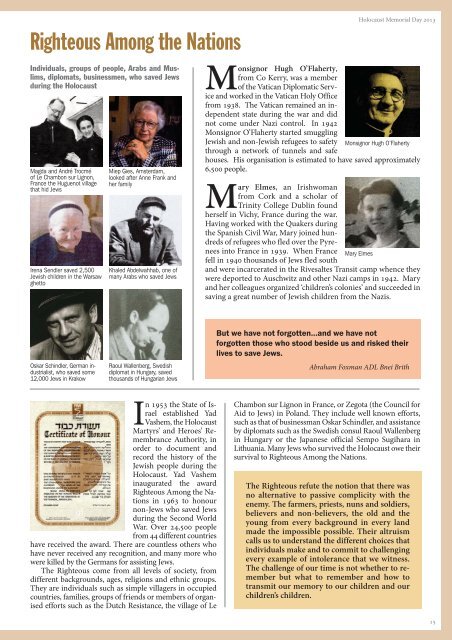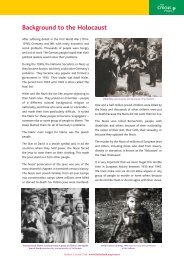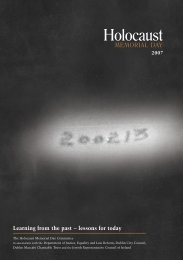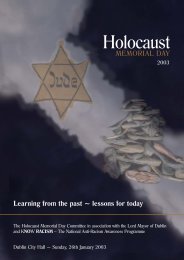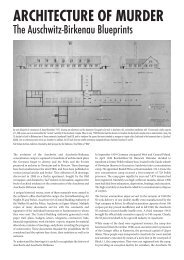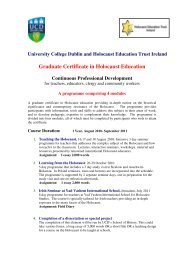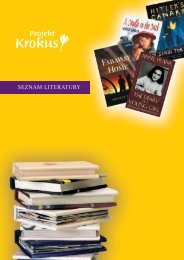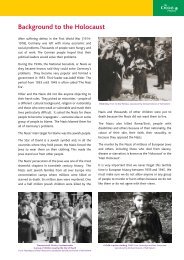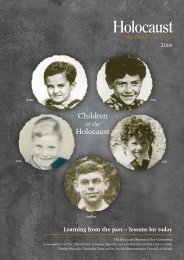19505_HMD_Cover:Layout 1 - Holocaust Education Trust Ireland
19505_HMD_Cover:Layout 1 - Holocaust Education Trust Ireland
19505_HMD_Cover:Layout 1 - Holocaust Education Trust Ireland
Create successful ePaper yourself
Turn your PDF publications into a flip-book with our unique Google optimized e-Paper software.
Righteous Among the Nations<br />
<strong>Holocaust</strong> Memorial Day 2013<br />
Individuals, groups of people, Arabs and Muslims,<br />
diplomats, businessmen, who saved Jews<br />
during the <strong>Holocaust</strong><br />
Magda and André Trocmé<br />
of Le Chambon sur Lignon,<br />
France the Huguenot village<br />
that hid Jews<br />
Irena Sendler saved 2,500<br />
Jewish children in the Warsaw<br />
ghetto<br />
Miep Gies, Amsterdam,<br />
looked after Anne Frank and<br />
her family<br />
Khaled Abdelwahhab, one of<br />
many Arabs who saved Jews<br />
Monsignor Hugh O’Flaherty,<br />
from Co Kerry, was a member<br />
of the Vatican Diplomatic Service<br />
and worked in the Vatican Holy Office<br />
from 1938. The Vatican remained an independent<br />
state during the war and did<br />
not come under Nazi control. In 1942<br />
Monsignor O’Flaherty started smuggling<br />
Jewish and non-Jewish refugees to safety Monsignor Hugh O’Flaherty<br />
through a network of tunnels and safe<br />
houses. His organisation is estimated to have saved approximately<br />
6,500 people.<br />
Mary Elmes, an Irishwoman<br />
from Cork and a scholar of<br />
Trinity College Dublin found<br />
herself in Vichy, France during the war.<br />
Having worked with the Quakers during<br />
the Spanish Civil War, Mary joined hundreds<br />
of refugees who fled over the Pyrenees<br />
into France in 1939. When France Mary Elmes<br />
fell in 1940 thousands of Jews fled south<br />
and were incarcerated in the Rivesaltes Transit camp whence they<br />
were deported to Auschwitz and other Nazi camps in 1942. Mary<br />
and her colleagues organized ‘children’s colonies’ and succeeded in<br />
saving a great number of Jewish children from the Nazis.<br />
Oskar Schindler, German industrialist,<br />
who saved some<br />
12,000 Jews in Krakow<br />
Raoul Wallenberg, Swedish<br />
diplomat in Hungary, saved<br />
thousands of Hungarian Jews<br />
But we have not forgotten…and we have not<br />
forgotten those who stood beside us and risked their<br />
lives to save Jews.<br />
Abraham Foxman ADL Bnei Brith<br />
In 1953 the State of Israel<br />
established Yad<br />
Vashem, the <strong>Holocaust</strong><br />
Martyrs’ and Heroes’ Remembrance<br />
Authority, in<br />
order to document and<br />
record the history of the<br />
Jewish people during the<br />
<strong>Holocaust</strong>. Yad Vashem<br />
inaugurated the award<br />
Righteous Among the Nations<br />
in 1963 to honour<br />
non-Jews who saved Jews<br />
during the Second World<br />
War. Over 24,500 people<br />
from 44 different countries<br />
have received the award. There are countless others who<br />
have never received any recognition, and many more who<br />
were killed by the Germans for assisting Jews.<br />
The Righteous come from all levels of society, from<br />
different backgrounds, ages, religions and ethnic groups.<br />
They are individuals such as simple villagers in occupied<br />
countries, families, groups of friends or members of organised<br />
efforts such as the Dutch Resistance, the village of Le<br />
Chambon sur Lignon in France, or Zegota (the Council for<br />
Aid to Jews) in Poland. They include well known efforts,<br />
such as that of businessman Oskar Schindler, and assistance<br />
by diplomats such as the Swedish consul Raoul Wallenberg<br />
in Hungary or the Japanese official Sempo Sugihara in<br />
Lithuania. Many Jews who survived the <strong>Holocaust</strong> owe their<br />
survival to Righteous Among the Nations.<br />
The Righteous refute the notion that there was<br />
no alternative to passive complicity with the<br />
enemy. The farmers, priests, nuns and soldiers,<br />
believers and non-believers, the old and the<br />
young from every background in every land<br />
made the impossible possible. Their altruism<br />
calls us to understand the different choices that<br />
individuals make and to commit to challenging<br />
every example of intolerance that we witness.<br />
The challenge of our time is not whether to remember<br />
but what to remember and how to<br />
transmit our memory to our children and our<br />
children’s children.<br />
15


